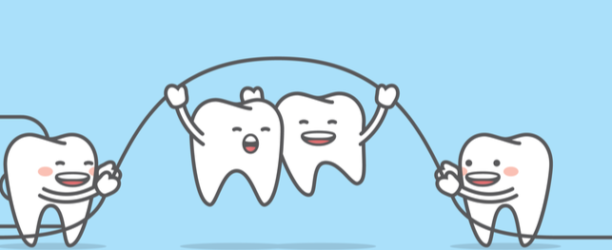A recent study conducted by the American Dental Association (ADA) revealed that just over 50% of Americans floss daily, while nearly 19% don’t floss at all. Unfortunately, not everyone realizes the importance of flossing, but we’re here to tell why it’s so important to floss once every day.
Brushing Only Does So Much
Flossing removes plaque buildup in the places where toothbrushes can’t reach – between teeth. Brushing alone only covers about 1/3 of the total tooth surface area in your mouth, which leaves a lot of space for plaque – and cavities – to thrive. Flossing helps fix this by removing food and other debris in between your teeth that causes plaque accumulation.
Not Flossing Can Lead to Gum Disease
A full flossing routine should include cleaning teeth below the gum line, where dental plaque can go unseen and unreached by toothbrushes. If left untreated, plaque buildup near the root of teeth can lead to gingivitis and tooth loss. Bleeding gums when brushing or flossing are often an early sign of gum disease. People who regularly brush and floss their teeth suffer from gum disease and tooth decay far less than those that do not.
Unhealthy Gums Can Lead to Other Diseases
While there is no conclusive evidence that gum disease leads to heart disease, researchers have identified a strong statistical link between the two illnesses. Gum disease leaves your body more prone to blood-borne infection, which can lead to inflammatory disease in other parts of your body. Flossing helps prevent gum disease, which can be an early indicator that your body is susceptible to more serious ailments.
Start Flossing Early
Recent studies have found that 43% of school-aged children have never flossed. To help familiarize your child with flossing, begin flossing their teeth as soon as their first two teeth touch. It’s important to get into a healthy mouth care routine with your children at an early age so that they can brush and floss as they get older and become more independent.
Flossing Tips
It’s never too late to begin flossing. Here’s a basic guide to flossing your children’s teeth:
1. Begin flossing your children’s teeth when any two teeth touch.
2. Use about 12-18 inches of dental floss. If that is too difficult, try using flossing tools like soft flossing picks.
3. Use wide, flat dental tape to floss your children’s teeth. The width of the floss helps with the larger spaces in children’s teeth.
4. Be gentle when flossing children’s teeth, and avoid applying too much pressure on their gums.
5. Floss both sides of the teeth, and make sure to gently dip beneath the gum lime.
For more detailed flossing pointers, check out this handy flossing guide provided by the ADA.
Find the Right Pediatric Dental Home for Your Children
Flossing is only one integral part of keeping young teeth clean and healthy. The AAPD recommends regular pediatric dental checkups for children every six months to help them stay healthy and cavity-free. If your family needs help finding a pediatric dental home in your neighborhood, then use our handy dental locator tool.

